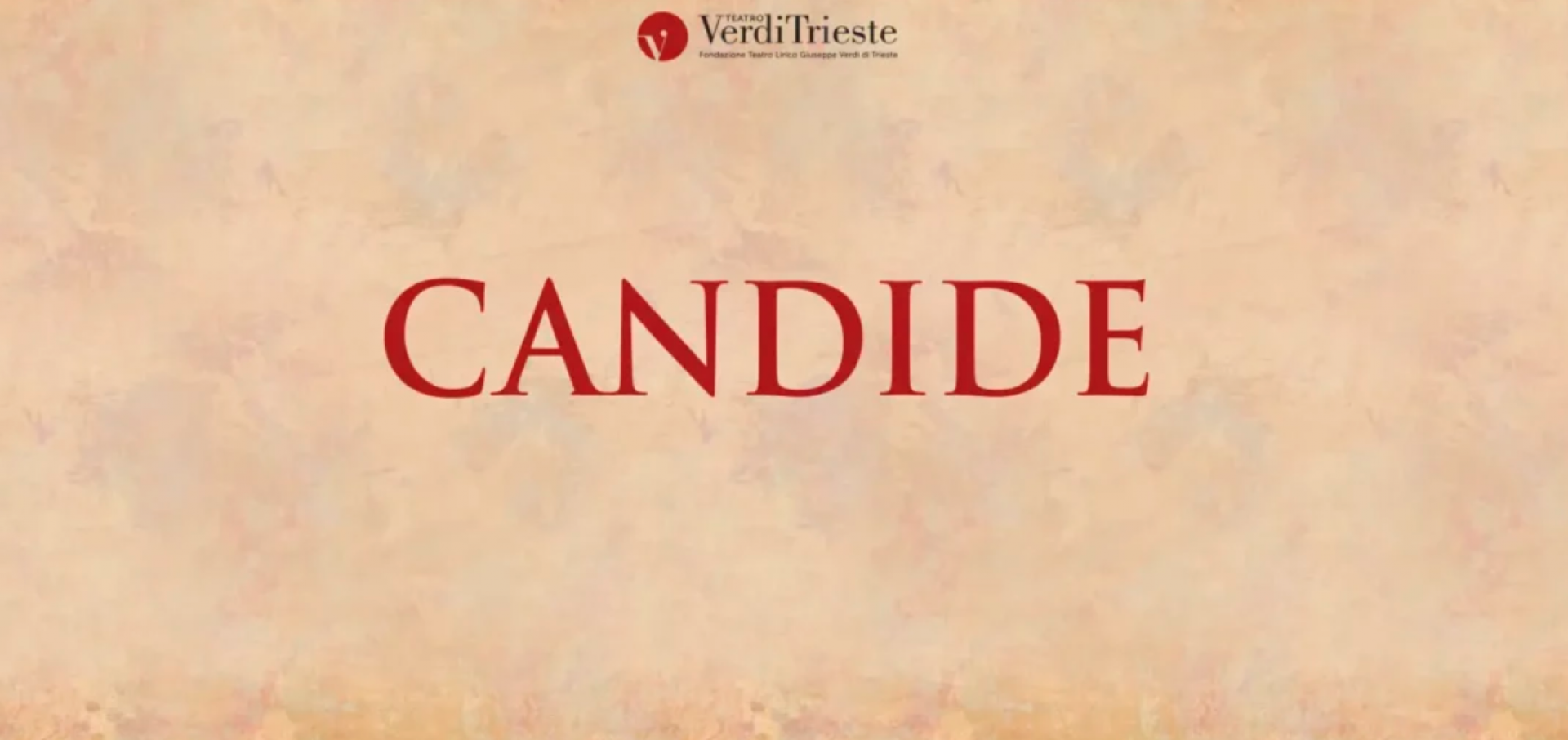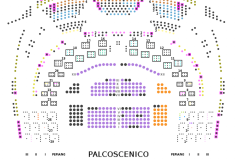Candide
Mo | Tu | We | Th | Fr | Sa | Su |
OPERA AND BALLET SEASON 2024-25
Candide
Opera by Leonard Bernstein
Synopsis
Bernstein "Final Revised Version" (1989)
Act 1
The operetta begins with an overture. The chorus welcomes everyone to Westphalia ("Westphalia Chorale") and Voltaire begins to narrate his story. Candide, the illegitimate nephew of Baron Thunder-ten-Tronck, lives in the Baron's castle Schloss Thunder-ten-Tronck. He is snubbed by the Baroness and bullied by her son Maximilian. Paquette, a very accommodating serving girl, also lives in the castle. However, Candide is in love with Cunegonde, the Baroness' daughter as Maximilian, Candide, Cunegonde and Paquette find their happiness in life ("Life is Happiness Indeed"). The four discover that Dr. Pangloss, a man thought to be the world's greatest philosopher, has taught them happiness ("The Best of All Possible Worlds"). The philosopher asks his four students to summarize what they have learned ("Universal Good"). When Cunegonde spies Dr. Pangloss being physically intimate with Paquette, he explains it away as being a "physical experiment", and she decides to share the "experiment" with Candide. Professing their love to each other at a park, Candide and Cunegonde dream of what married life would look like ("Oh, Happy We"). The Baron, however, is angered at what Candide has done to Cunegonde, as he is a social inferior. Candide is promptly exiled, wandering alone with his faith and optimism to cling to ("It Must Be So"). He is then shanghaied by and into the Bulgar Army, which plots to "liberate" all of Westphalia. His escape attempt fails, and is recaptured by the Army. The Bulgar Army attacks Schloss Thunder-ten-Tronck and in the castle the Baron's family prays as the chorus joins in ("Westphalia"). However, the Baron, the Baroness, Maximilian, Paquette, Pangloss and (after being repeatedly ravished by the Bulgar Army) Cunegonde are all killed in the attack ("Battle Music"). Candide returns to the castle's ruins and searches for Cunegonde ("Candide's Lament").
Some time later, Candide becomes a beggar. He gives the last of his coins to Pangloss, who reveals that he was revived by an anatomist's scalpel. He then tells Candide of his syphilis condition brought on by Paquette ("Dear Boy"). A merchant offers the two employment before sailing off to Lisbon. However, as they arrive, a volcano erupts and the ensuing earthquake results in the death of 30,000 people. Pangloss and Candide are blamed for the disaster, arrested as heretics and publicly tortured by order of the Grand Inquisitor. Pangloss is hanged and Candide is flogged("Auto-da-Fé"). Candide eventually ends up in Paris, where Cunegonde shares her favors (on different mutually-agreed-upon days of the week) with wealthy Jew Don Issachar and the city's Cardinal Archbishop ("The Paris Waltz"). She contemplates what she has done to survive while in Paris ("Glitter and Be Gay"). Candide finds Cunegonde and reunites with her ("You Were Dead, You Know"). However, the Old Lady, Cunegonde's companion, forewarns Cunegonde and Candide of Issachar and the Archbishop's arrival. Candide inadvertently kills both of them by stabbing them with a sword.
The three flee to Cadiz with Cunegonde's jewels, where the Old Lady tells Candide and Cunegonde about her past. The jewels are stolen and the Old Lady offers to sing for their dinner ("I Am Easily Assimilated"). The French police arrive, intending to arrest Candide for murdering Don Issachar and the Archbishop. Accepting an offer to fight for the Jesuits in South America, Candide decides to take Cunegonde and the Old Lady to the New World, and the three begin their journey on a ship ("Quartet Finale").
Act 2
In Montevideo, Maximilian and Paquette, now revived and disguised as slave girls, reunite. Soon after, Don Fernando d'Ibaraa y Figueroa y Mascarenes y Lampourdos y Souza, the governor of the city, falls in love with Maximilian, but quickly realizes his mistake and sells him to a priest. Meanwhile, Candide, Cunegonde and the Old Lady also arrive in Montevideo, where the Governor falls in love with Cunegonde ("My Love"). The Old Lady convinces Cunegonde that her marriage to the governor will support her financially ("We Are Women"). Candide soon befriends Cacambo and accepts him as his valet. Convinced by the Old Lady that the police are still after Candide for the Archbishop's murder, Candide and Cacambo flee Montevideo and eventually stumble upon a Jesuit camp and are joined by the Father and Mother Superiors ("The Pilgrims' Procession – Alleluia"). Candide soon discovers that the Mother Superior is actually Paquette and the Father Superior is Maximilian. When Candide tells Maximilian that he will marry Cunegonde, however, Maximilian angrily challenges him to a fight. However, Maximilian is once again inadvertently stabbed to death by Candide. Candide is forced to flee into the jungle as a result.
Three years later, Cunegonde and the Old Lady discuss the miseries shared by the upper classes while the Governor does not want to hear their complaints ("Quiet"). Meanwhile, Candide and Cacambo are starving and lost in the jungles. Finding a boat in the ocean, they float downriver into a cavern for 24 hours until they finally reach Eldorado, the city of gold ("Introduction to Eldorado"). The two discover that the locals worship one god as opposed to three, palaces of science, rosewater and stones with cinnamon and clove scents. Dissatisfied without Cunegonde, Candide decides to leave. The locals think him foolish, but offer to help, giving him some of the town's golden sheep and constructing a lift that will guide him, Cacambo and the sheep over the mountain ("The Ballad of Eldorado"). One by one, the sheep die until only two remain. Unwilling to go back to Montevideo, Candide gives Cacambo one of the golden sheep to ransom Cunegonde, telling them that they will meet again in Venice.
Arriving in Suriname, Candide meets Martin, a local pessimist. He shows him a slave with one hand and one foot lost while harvesting sugarcane, which is the result of Europeans eating sugar; Candide is unable to convince Martin otherwise ("Words, Words, Words"). Vanderdendur, a Dutch villain, offers his ship, the Santa Rosalia, in exchange for the golden sheep. Candide is excited when he is told that the Santa Rosalia is to depart for Venice. The locals and Vandendur wish Candide a safe journey to Venice ("Bon Voyage"). However, the ship sinks and Martin drowns as a result. After reuniting with his golden sheep, Candide is picked up by a galley, meeting five deposed kings. The galley is rowed by slaves, including Pangloss, revived once again. The kings say that they will live humbly, serving both god and men, and Pangloss leads their debate ("The Kings' Barcarolle").
The ship arrives in Venice, where the Carnival festival is taking place ("Money, Money, Money"). While the kings play roulette and baccarat, Candide searches for Cunegonde. Maximilian, revived once again, is now the corrupt Prefect of Police and the town's leader. Paquette is now the town's reigning prostitute. Cunegonde and the Old Lady are employed to encourage the gamblers ("What's the Use?"). Pangloss celebrates a victory after winning roulette and spends his money on the other ladies ("The Venice Gavotte"). Candide, however, masked for the Carnival, is accosted by Cunegonde and the Old Lady (both of whom are also masked), who try to swindle him out of his money. During the exchange, all the masks come off and they are horrified to recognize each other. Seeing what Cunegonde has become, Candide's image of and belief in her is shattered ("Nothing More Than This"). Candide does not speak for several days; with what little money they have left, they purchase a small farm outside Venice and the chorus says that life is just life and paradise is nothing ("Universal Good"). Candide finally speaks and resolves to marry Cunegonde ("Make Our Garden Grow").
Program and cast
Conductor KEVIN RHODES
Director: RENATO ZANELLA
Set designer: ALESSANDRO CAMERA
PRODUCTION BY FONDAZIONE TEATRO LIRICO GIUSEPPE VERDI DI TRIESTE IN CO-PRODUCTION WITH FONDAZIONE TEATRO COMUNALE DI BOLOGNA
Choir Master: PAOLO LONGO
ORCHESTRA, CHOIR AND TECHNICIANS BY FONDAZIONE TEATRO LIRICO GIUSEPPE VERDI DI TRIESTE
Teatro Verdi Trieste
The Teatro Lirico Giuseppe Verdi is an opera house located in Trieste, Italy and named after the composer Giuseppe Verdi. Privately constructed, it was inaugurated as the Teatro Nuovo to replace the smaller 800-seat "Cesareo Regio Teatro di San Pietro" on 21 April 1801 with a performance of Johann Simon Mayr's Ginevra di Scozia. Initially, the Nuovo had 1,400 seats. In 1821, it became known as the Teatro Grande.
By the end of the 18th century, the need for a new theatre in Trieste became evident. Its main theatre, the Teatro di San Pietro, had become increasingly inadequate and finally closed its doors in 1800. A proposal to the Austrian Chancery from Giovanni Matteo Tommasini to build a private theatre had existed since 1795 and, in June 1798, a contract was drawn up whereby annual funding would come from the municipality and Tommasini would hold the rights to several boxes and the rights to sell others. Gian Antonio Selva, the architect of the La Fenice in Venice, was engaged, and he designed a classic horseshoe-shaped auditorium. However, his exterior designs were considered to be too plain for the Austrians who then engaged another architect, Matteo Pertsch, to solve the problem, which was accomplished by incorporating elements of Milan's La Scala opera house. The "Nuovo" became a mixture of La Fenice on the inside and La Scala on the exterior.
History
Several name changes have occurred during the theatre's lifetime, the first in 1821 when it became the Teatro Grande [1] and it was under this name that the theatre was the site of two Verdi opera premieres: Il corsaro in 1848 (featuring the soprano Giuseppina Strepponi, who Verdi married in 1859, in the leading role) and Stiffelio, a production which Verdi supervised - not without controversy - in 1850.[2] However, before these premieres, Verdi's operas had begun to dominate the Teatro Grande's stage, followed, as the century progressed, by all the major works of the opera repertoire, including those by Puccini and Wagner.
A further name change followed in 1861 due to a change from private to public ownership. Thus it became the Teatro Comunale and existed as such throughout the latter years of the 19th century. By 1881, seating capacity had been increased to 2,000 through the use of existing standing room spaces; but, by that December, the theatre was declared to be unsafe and it was closed for renovations, during which electricity replaced gas lighting for the reopening in 1889 with 1,000 seats.
Within hours of his death in January 1901,[3] the theatre was once again renamed, this time to honour the memory of Giuseppe Verdi. It was extensively restored between 1992 and 1997 and re-opened with about 1,300 seats[4] and with a Viva Verdi concert[3] which included excerpts from many of the composer's operas. (Like the restoration of La Scala between 2001 and 2004, a temporary alternative venue was quickly created in Trieste and the Sala Tripcovich continues to offer space for chamber opera and operettas.)
A major feature of the Teatro Verdi's programming in the past 40 years, which stems from the original Austrian occupation of the city in the 19th century and the fact that Trieste did not become part of Italy until 1918, is the "International Festival of Operetta" which takes place every summer.
Premieres
The theatre has seen the world premieres of the following operas:
Ginevra di Scozia by Simon Mayr, 21 April 1801
Annibale in Capua by Antonio Salieri 20 May 1801
Ricciarda di Edimburgo by Cesare Pugni, 29 September 1832.
Enrico II by Otto Nicolai, 26 November 1839
Il corsaro by Giuseppe Verdi, 25 October 1848
Stiffelio by Giuseppe Verdi, 16 November 1850
Nozze istriane by Antonio Smareglia, 28 March 1895

 EN
EN DE
DE IT
IT FR
FR ES
ES RU
RU JP
JP RO
RO
 Seating plan
Seating plan 